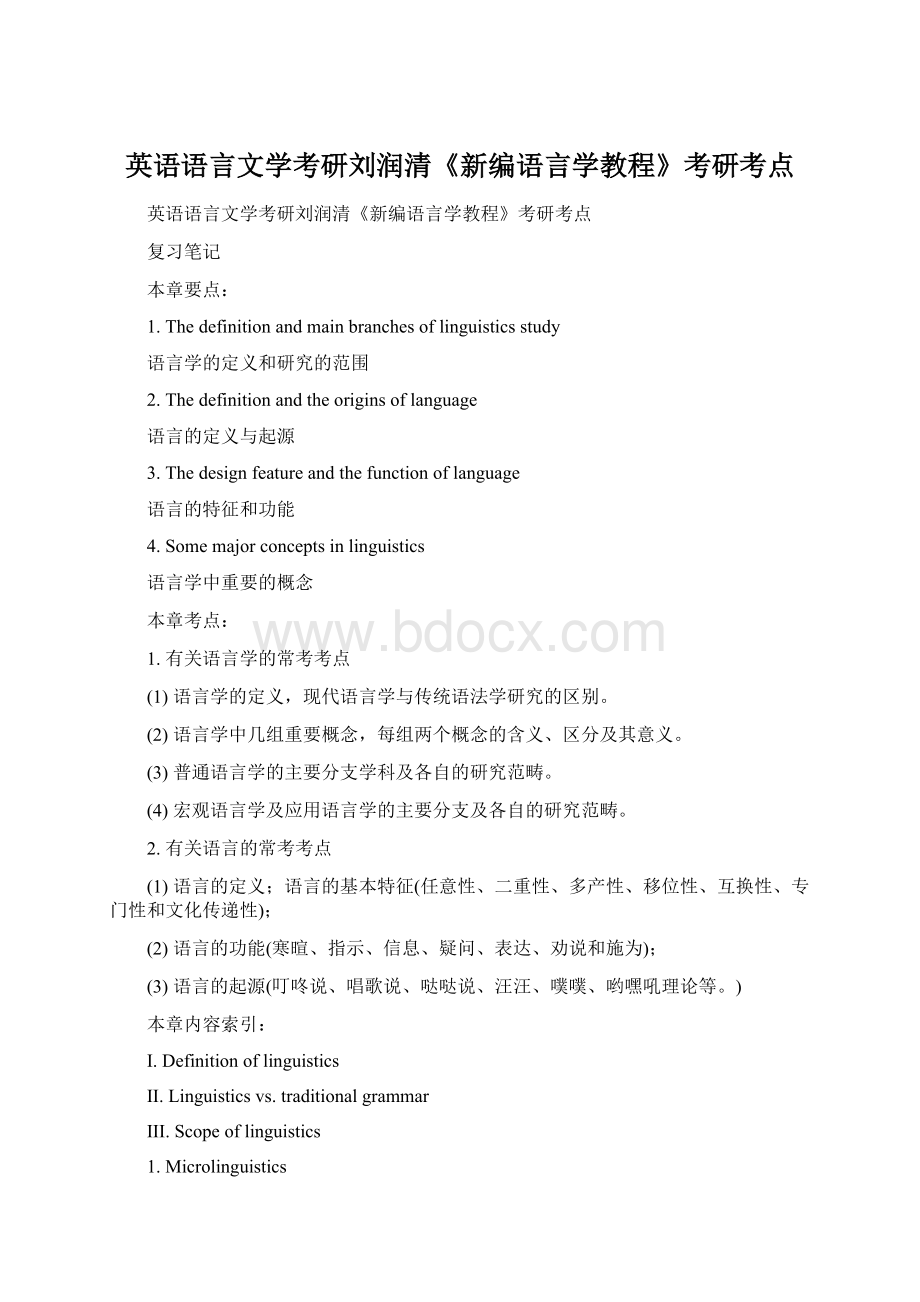英语语言文学考研刘润清《新编语言学教程》考研考点.docx
《英语语言文学考研刘润清《新编语言学教程》考研考点.docx》由会员分享,可在线阅读,更多相关《英语语言文学考研刘润清《新编语言学教程》考研考点.docx(8页珍藏版)》请在冰豆网上搜索。

英语语言文学考研刘润清《新编语言学教程》考研考点
英语语言文学考研刘润清《新编语言学教程》考研考点
复习笔记
本章要点:
1.Thedefinitionandmainbranchesoflinguisticsstudy
语言学的定义和研究的范围
2.Thedefinitionandtheoriginsoflanguage
语言的定义与起源
3.Thedesignfeatureandthefunctionoflanguage
语言的特征和功能
4.Somemajorconceptsinlinguistics
语言学中重要的概念
本章考点:
1.有关语言学的常考考点
(1)语言学的定义,现代语言学与传统语法学研究的区别。
(2)语言学中几组重要概念,每组两个概念的含义、区分及其意义。
(3)普通语言学的主要分支学科及各自的研究范畴。
(4)宏观语言学及应用语言学的主要分支及各自的研究范畴。
2.有关语言的常考考点
(1)语言的定义;语言的基本特征(任意性、二重性、多产性、移位性、互换性、专门性和文化传递性);
(2)语言的功能(寒暄、指示、信息、疑问、表达、劝说和施为);
(3)语言的起源(叮咚说、唱歌说、哒哒说、汪汪、噗噗、哟嘿吼理论等。
)
本章内容索引:
I.Definitionoflinguistics
II.Linguisticsvs.traditionalgrammar
III.Scopeoflinguistics
1.Microlinguistics
2.Macrolinguistics
IV.Definitionoflanguage
V. Originsoflanguage
1.Ding-DongTheory
2.Sing-SongTheory
3.Pooh-PoohTheory
4.Yo-He-HoTheory
5.Ta-TaTheory
6.Bow-WowTheory
VI. Designfeaturesoflanguage
1.Arbitrariness
2.Duality
3.Productivity
4.Interchangeability
5.Displacement
6.Specialization
7.Culturaltransmission
VII.Functionsoflanguage
1.Phaticfunction/communion
2.Directivefunction
3.Informativefunction
4.Interrogativefunction
5.Expressivefunction
6.Evocativefunction
7.Performativefunction
VIII.Somemajorconceptsinlinguistics
1.Descriptiveandprescriptivegrammar
2.Synchronicanddiachroniclinguistics
3.Langueandparole
4.Competenceandperformance
5.Syntagmaticandparadigmaticrelations
6.Functionalismandformalism
I.Definitionoflinguistics(语言学的定义)
【考点:
名词解释】
Thescientificorsystemicstudyoflanguage,whichisalwaysguidedbythe-threecanonsofscience:
exhaustiveness,consistencyandeconomy.
语言学是对语言的科学或系统的研究。
语言学研究的科学性可以归纳为:
穷尽性、一致性以及简洁性。
II.Linguisticsvs.traditionalgrammar(语言学与传统语法)
Linguisticsdiffersfromtraditionalgrammaratleastinthreebasicways.
1.Linguisticsdescribeslanguagesanddoesnotlaydownrulesofcorrectness.
2.Linguistsregardthespokenlanguageasprimary,notthewritten.
3.Linguisticsdescribeseachlanguageonitsownmerits.
语言学在以下三方面不同于传统语法。
1.语言学描述语言而非设定规则。
2.语言学认为口语是基础而非文字。
3.语言学描述不同的语言,而非一概而论。
III.Scopeoflinguistics(语言学的研究范畴)
1.Microlinguistics(微观语言学)
Phonetics语音学
Phonology音系学
Morphology形态学
Syntax句法学
Semantics语义学
Pragmatics语用学
2.Macrolinguistics(宏观语言学)
Sociolinguistics社会语言学
Psycholinguistics心理语言学
Neurolinguistics神经语言学
Stylistics文体学
Discourseanalysis语篇分析
Computationallinguistics计算语言学
Cognitivelinguistics认知语言学
Appliedlinguistics应用语言学
IV.Definitionoflanguage(语言的定义)
【考点:
名词解释】
1.Languageisasystem—elementsinitarenotarrangedandcombinedrandomly,butaccordingtosomerulesandprinciples.
2.Languageisarbitrary—thereisnointrinsicconnectionbetweentheword(e.g.pen)andthething(e.g.whatwewritewith).
3.Languageisvocal—theprimarymediumforalllanguagesissound.
4.Languageisusedforhumancommunication—itishuman-specific,verydifferentfromsystemsofanimalcommunication.
1.语言是一个系统——其元素非任意排列,而是根据一定规则组合的。
2.语言是任意的——词与其所指物之间没有内在的联系。
3.语言是口头的——是所有语言的基本交流形式。
4.语言是人类用来交流的工具——不同于动物的交流系统。
V. Originsoflanguage(语言的起源)
1.Ding-DongTheory(叮咚理论)
Humanspeechdevelopedfromprimitivemangivingvocalexpressiontotheobjectsheencountered.
语言起源于原始人对物体的口头表达。
2.Sing-SongTheory(唱歌说)
Languagedevelopedfromprimitiveritualsongsofpraise.
语言起源于原始仪式赞美的歌声。
3.Pooh-PoohTheory(噗噗理论)
Languagecamefrominterjections,whichexpressthespeaker’semotions.
语言来源于人本能表达情感的声音。
4.Yo-He-HoTheory(呦嘿吼理论)
Languagecamefromthecriesuttered,duringstrainofwork.
语言来源于共同劳动时发出的呦嘿声。
5.Ta-TaTheory(哒哒说)
Languagecamefromthecombinationofcertaingesturesandtonguemovements.
语言来源于移动舌头发出的声音与某个手势的结合。
6.Bow-WowTheory(汪汪理论)
Languagecamefromimitationofanimalcriesandothersoundsheardinnature.
语言起源于人们模仿动物的叫声和其他自然界中的声音。
VI. Designfeaturesoflanguage(语言的定义特征)
【重点、考点:
论述语言的识别特征】
1.Arbitrariness(任意性)
Thisreferstothefactthatthereisnologicalorintrinsicconnectionbetweenaparticularsoundandthemeaningitisassociatedwith.Thereisnoreason,forexample,whyEnglishshouldusethesounds/dɔg/torefertotheanimaldog,orwhyChineseshoulduse“gou”torefertothesameanimal.Therelationshipbetweenthesoundsandtheirmeaningisquiteaccidental.
任意性是指某个符号的声音与意义之间没有逻辑或内在联系。
例如,英文中用/dɔg/来指动物狗,而中文却用“gou”。
单词的声音与其意义之间的关系是任意的。
2.Duality(二重性)
Languageoperatesontwolevelsofstructure.Atonelevelareelementswhichhavenomeaninginthemselvesbutwhichcombinetoformunitsatanotherlevelwhichdohavemeaning.Forinstance,humanlanguagehasanumberofsoundunits,orphonemes,buteachphonemeisnormallymeaninglessinisolation.Itbecomesmeaningfulonlywhenitiscombinedwithotherphonemes.
语言结构具有二重性。
其中一层结构本身是没有意义的,但是它会与另外具有意义的一层相结合。
比如,人类语言中的音素,独立的音素本身通常是没有意义的,当与其他因素结合起来才有可能产生意义。
3.Productivity(多产性)
Productivityorcreativityreferstoman’slinguisticabilitywhichenableshimtoproduceandunderstandaninfinitelylargenumberofsentencesinournativelanguage,includingthesentenceswhichwereneverheardbefore.
多产性是指人们的一种语言能力,能使人们用母语说出或者明白无限多的句子,有些我们以前从未听过的句子。
4.Interchangeability(互换性)
Interchangeabilityorreciprocityreferstothefactthatmancanbothproduceandreceivemessages,andhisrolesasaspeakerandahearercanbeexchangedatease.
互换性是指人可以是信息的发出者,也可以是信息的接受者,即人作为说话者和听话者的角色是可以随意更换的。
5.Displacement(移位性)
Displacementisapropertyoflanguageenablingpeopletotalkaboutthingsremoteeitherinspaceorintime.
移位性能使人们谈论距离和时间上不可及的事物。
6.Specialization(专门性)
Specializationreferstothefactthatmandoesnothaveatotalphysicalinvolvementintheactofcommunication.
专门性是指人们在交流过程中并不是全身的运动,只通过语言即可交流。
7.Culturaltransmission(文化传递性)
Languageisculturallytransmitted.Itcannotbetransmittedthroughheredity.AChinesebabybornandbroughtupinLondonbyanEnglishfamilywillspeakEnglish,whileanEnglishchildbroughtupinBeijingbyaChineseauntwillspeakChinese.
语言是通过文化传递的,而不是遗传的。
一个中国小孩在伦敦长大的话就会说英文,而一个英国小孩在北京长大的话就会说中文。
VII.Functionsoflanguage(语言功能)
1.Phaticfunction/communion(寒暄功能)
Languageisusedtoestablishanatmosphereormaintainsocialcontactbetweenthespeakerandthehearer.Greetings,farewells,andcommentsontheweatherservethisfunction.
语言能够在说话者与听话者之间建立一种气氛或是维持两者间的社会关系,如问候语、送别及谈论天气的对话。
2.Directivefunction(指示功能)
Languageisusedtogetthehearertodosomething.Mostimperativesentencesareofthisfunction.
语言能使听话者按照听到的话去做。
大部分祈使句都体现了这种功能。
3.Informativefunction(信息功能)
Languageisusedtotellsomething,togiveinformation,ortoreasonthingsout.Declarativesentencesservethisfunction.
语言用来陈述某件事情,提供信息或用作推理,一般出现在陈述句中。
4.Interrogativefunction(疑问功能)
Languageisusedtoaskforinformationfromothers.Allquestionsexpectingrepliesservethisfunction.
语言用来向他人提问而获取信息。
需回答的疑问句体现了此功能。
5.Expressivefunction(表达功能)
Languageisusedtorevealthespeaker’sattitudesandfeelings.Ejaculationsservethisfunction,suchas“MyGod!
”and“Goodheavens!
”
语言用来表达说话者的态度与感受。
感叹句体现了此功能,例如“我的天啊!
”
6.Evocativefunction(唤起功能)
Languageisusedtocreatecertainfeelingsinthehearers.Jokes,advertising,andpropagandaservethisfunction.
语言用来使听话者产生某种感情。
开玩笑,广告还有宣传中的语言体现了这一功能。
7.Performativefunction(施为功能)
Languageisusedtodothingsortoperformacts.Thejudge’simprisonmentsentences,thepresident’sdeclarationofwarortheQueen’snamingofaship,etc.,servethisfunction.
语言用来实施一种行为。
比如入狱判刑,总统宣战,女皇为船舰命名等体现了语言的这种职能。
VIII.Somemajorconceptsinlinguistics(语言学中的主要概念)
1.Descriptiveandprescriptivegrammar(描写式与规定式语法)
(1)Descriptivegrammarsattempttotellwhatisinthelanguage;whileprescriptivegrammarstellpeoplewhatshouldbeinthelanguage.
(2)Astraditionalgrammarstriedtolaydownrules,theyareoftencalledprescriptive.Mostmodernlinguisticsisdescriptive.
(1)描写式语法旨在对语言进行描述,而规定式语法旨在规定语言应该如何。
(2)传统与法学家试图规定语言规则,这就是规定式语法。
现代语言学基本上是描写式语法。
2.Synchronicanddiachroniclinguistics(共时与历时语言学)
Whenwestudylanguageatoneparticulartime,itiscalledsynchroniclinguistics.Whenwestudylanguagedevelopmentsthroughtime,itiscalleddiachronicorhistoricallinguistics.
Synchroniclinguisticsfocusesonthestateoflanguageatanypointinhistorywhilediachroniclinguisticsfocusesonthedifferencesintwoormorethantwostatesoflanguageoverdecadesorcenturies.
对语言在历史上的某一时间点进行的描写就是共时性语言学;对语言随时间变化而变化进行的描写就是历时性语言学。
共时语言学集中研究历史任何时期点的语言现状,而历时语言学集中研究几十年或几百年的时期内两个或比两个更多的语言状况的差异。
3.Langueandparole(语言与言语)
(1) F. deSaussuremadeanimportantdistinctionbetweenlangueandparole.
(2)Languereferstotheabstractlinguisticsystemsharedbyallthemembersofaspeechcommunity.Parolereferstoparticularrealizationsoflangue.
(3)Langueisthesocial,conventionalsideoflanguage,whileparoleisindividualizedspeech.
(1)索绪尔对语言和言语做了重要区分。
(2)语言是指一个语言群体的所有成员所共有的抽象的语言系统。
言语是指语言的具体实现和运用。
(3)语言是社会的,约定性的,而言语是个人的话语。
4.Competenceandperformance(语言能力和语言应用)
AccordingtoChomsky,competencereferstotheknowledgethatnativespeakershaveoftheirlanguageasasystemofabstractformalrelations,whileperformancereferstotheiractuallinguisticbehavior,thatis,theactualuseofthisknowledge.
根据乔姆斯基的理论,一名语言使用者对于语言规则系统的潜在认识称为他的语言能力。
语言运用指在具体场景中语言的实际运用。
5.Syntagmaticandparadigmaticrelations(组合与聚合关系)
Saussurehasputforwardanotherpairofconcepts:
syntagmaticandparadigmaticrelations.Theformerreferstothehorizontalrelationshipbetweenlinguisticelements,whichformlinearsequences.Thelatermeanstheverticalrelationshipbetweenforms,whichmightoccupythesameparticularplaceinastructure.
索绪尔提出了另一对概念:
组合与聚合关系。
前者是指语言要素之间的水平关系,呈线形结构。
后者是指语言形式间的垂直关系,在结构中也许在同一结构。
6.Functionalismandformalism(功能主义与结构主义)
【重点、考点:
区分功能观与句子观】